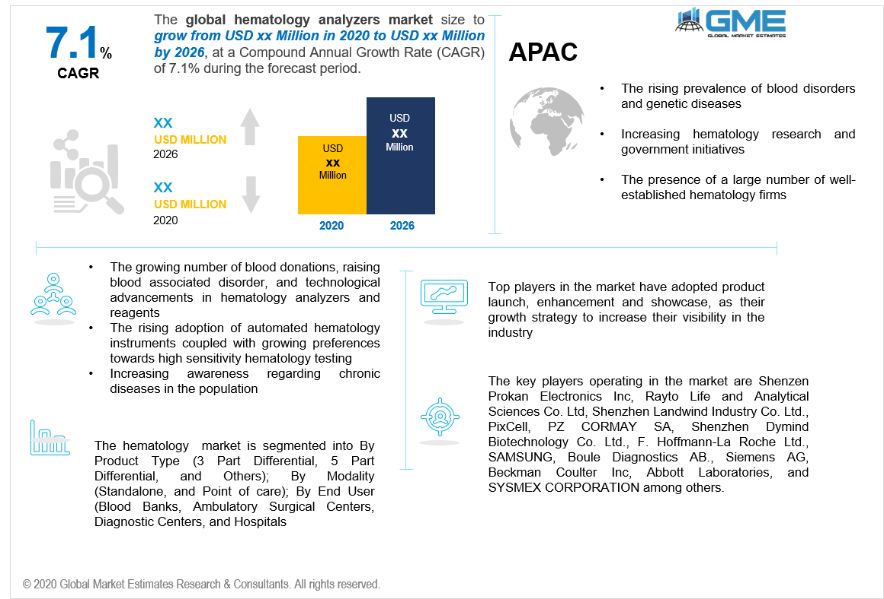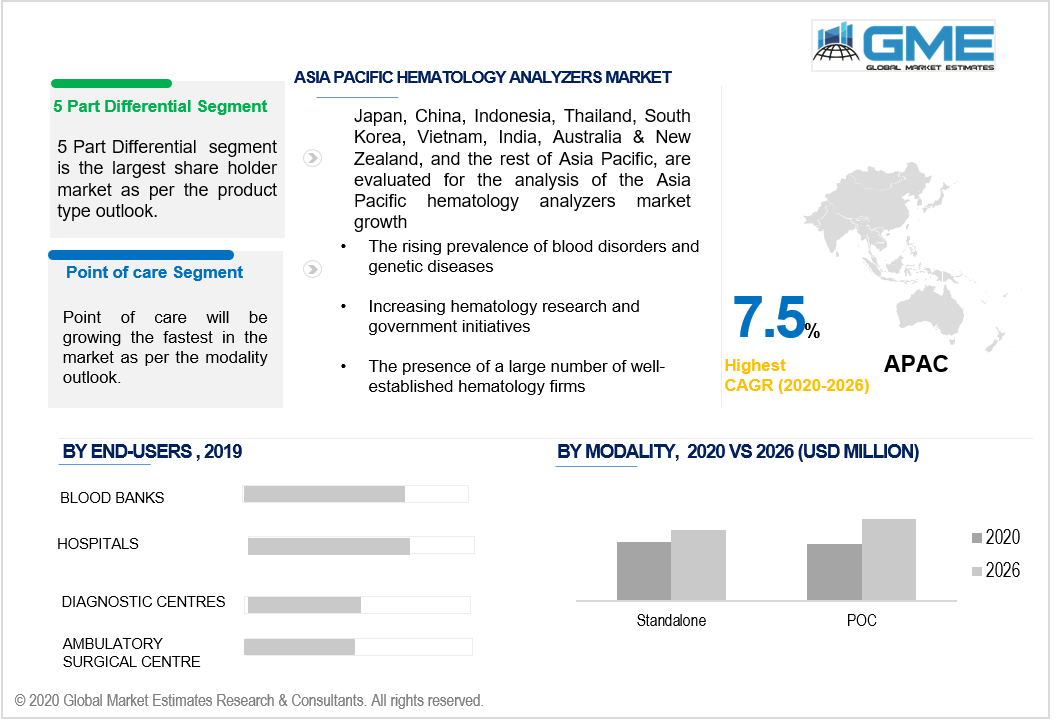
Global Hematology Analyzers Market Size, Trends & Analysis - Forecasts to 2026 By Product Type (3 Part Differential, 5 Part Differential, and Others); By Modality (Standalone, and Point of care); By End User (Blood Banks, Ambulatory Surgical Centers, Diagnostic Centers, and Hospitals); By Region (North America, Europe, Asia Pacific, MEA, and CSA); End-User Landscape, Vendor Landscape, and Company Market Share Analysis & Competitor Analysis
Hematology analyzers are used for blood sample analysis by getting the count of the total number of WBCs and conducting a reticulocytes analysis. They aid in numerous disease diagnoses such as viruses, cancer, anemia, infections, genetic problems, and diabetes. Hospitals, research institutions, and clinical testing laboratories are a few of the end-users of hematology analyzers. These analyzers are used to comprehend cellular constituents and their existence.
According to GME studies, the hematology analyzers market is estimated to grow at a CAGR of 7.1% between 2020-2026 period. Market growth is mainly propelled by factors such as the growing number of blood donations, raising blood associated disorder, and technological advancements in hematology analyzers and reagents. Also increasing awareness regarding chronic diseases in the population is adding to the demand of the market in recent times. Integration of hematology analyzers with flow cytometry will act as a driver for the market growth.

3 part differential, 5 part differential, and others are the bifurcations of the hematology analyzers based on types of product. Out of the two, a 5-part differential has shown the dominant market growth as it can offer more intricate know-how on the WBCs. However, 3-part instruments can offer great cost benefits with sufficient information for the most clinical setting.
Based on modality, the hematology analyzer market can be studied as a standalone, and point of care. Standalone is anticipated to show dominance however POC is expected to grow at the fastest rate in the projected timespan. The POC market is further expected to grow owing to increasing demand for POC based analyzers and growing compatibility with an electronic medical record system.
Blood banks, ambulatory surgical centers, diagnostic centers, and hospitals are the application segmentation of the hematology analyzers. Blood banks are one of the critical market builders of the hematology analyzers as these analyzers are involved in various screening steps. These screening tests are implied to distinguish the type of blood and for detection of various diseases which cause increased demand for hematology analyzers.

Asia-Pacific is projected to lead the hematology analyzers market at the fastest rate in the aforementioned period. The rising prevalence of blood disorders and genetic diseases is the primary reason behind the significant growth of the market. Also increasing hematology research and government initiatives within this region influence the growth of this market in this region. The presence of a large number of well-established hematology firms is adding lucrative opportunities for the hematology analyzers market in the forecast period.
The key players operating in the market include Shenzen Prokan Electronics Inc, Rayto Life and Analytical Sciences Co. Ltd, Shenzhen Landwind Industry Co. Ltd., PixCell, PZ CORMAY SA, F. Hoffmann-La Roche Ltd., SAMSUNG, Edan Instruments, Inc, Cellavision, Diatron, HORIBA Ltd., Mindray, Nihon Kohden Corporation, Boule Diagnostics AB., Siemens AG, Beckman Coulter Inc, Abbott Laboratories, and SYSMEX CORPORATION among others.
Please note: This is not an exhaustive list of companies profiled in the report.
In February 2020, Sysmex came into a joined agreement with McKesson for the dispensation of Sysmex’s XW-100 automated hematology analyzers in the US region.
In July 2017, Sysmex launched an automated hematology slide preparation unit named XN-9100, XN-3100, XN-1500, and SP-50.
We value your investment and offer free customization with every report to fulfil your exact research needs.
The Global Hematology Analyzers Market has been studied from the year 2017 till 2026. However, the CAGR provided in the report is from the year 2018 to 2026. The research methodology involved three stages: Desk research, Primary research, and Analysis & Output from the entire research process.

The desk research involved a robust background study which meant referring to paid and unpaid databases to understand the market dynamics; mapping contracts from press releases; identifying the key players in the market, studying their product portfolio, competition level, annual reports/SEC filings & investor presentations; and learning the demand and supply side analysis for the Hematology Analyzers Market.

The primary research activity included telephonic conversations with more than 50 tier 1 industry consultants, distributors, and end-use product manufacturers.

Finally, based on the above thorough research process, an in-depth analysis was carried out considering the following aspects: market attractiveness, current & future market trends, market share analysis, SWOT analysis of the companies and customer analytics.

Tailor made solutions just for you
80% of our clients seek made-to-order reports. How do you want us to tailor yours?
OUR CLIENTS